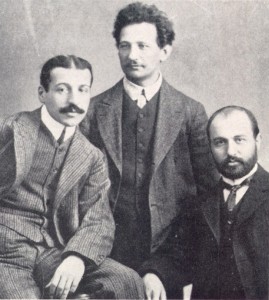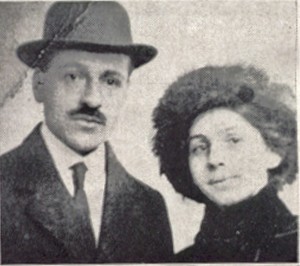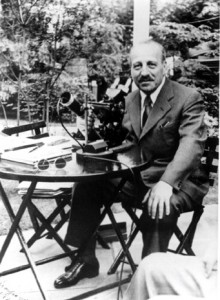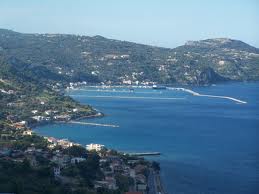The beautiful provincial town, Kymi of Evia, was the place where George N. Papanicolaou spent the first years of his life.
He was born on May 13th 1883, being the third child of Nikolaos and Maria Papanicolaou, (family name Kritsouta).
His father, doctor and politician, offered a lot to his homeland as a Deputy of the Greek Parliament (province of Karystia) and Mayor of Kymi. As a politician he was an admirer and faithful follower of the prime minister, Charilaos Trikoupis. His spouse Maria, a woman with impressive appearance, culture and kindness, was considered to be a highly respectable and lovable person.
Thus George spent his childhood in an environment, in which nature was tied up with existence and love with life. “I permanently recall my childhood and juvenile life in our fatherly house”, he wrote on 1958.
After his graduation from the Primary school of Kymi, he moved to Athens to continue his high school studies. It was obvious that he was dowered with exceptional sensitivity, extraordinary cleverness, love of learning and strong will.
He began to learn French, a language with international appeal, that was considered to be an asset for a cultivated individual of the time. Having a real flair for music, he attended violin courses in the Lotner Conservatory for eight years. With his continuously increasing interest for literature, poetry and philosophy, he became a highly educated man.
In 1898 he entered the Athens University Medical Faculty. During his academic years he was connected to students of the Philosophy Faculty committed to the Dimotikismos movement. Among them we can distinguish Dimitris Glinos and Alexandros Delmouzos, who later played a leading role in education consultancy.
When Papanicolaou graduated from Medical School and completed his military obligations, it was the time for him to decide about his career.
He rejected without hesitation his father’s proposal to make a career as doctor or still to ensure a place as a military doctor, since his uneasy spirit did not afford such solutions. In his letter of the 31th of December 1904, he wrote to his father: “no, I do not want to become a military doctor. I want to remain free, to feel the joy of the fight for life. I am not scared of the sea. I need my freedom, my sweet freedom”.
So he finally convinced his father to send him for postgraduate studies abroad (Germany).
In his decision to select Germany as the place for postgraduate studies, he was urged by his precious friend Alekos Delmouzos.
They were both influenced by the big German writers and philosophers: Goethe, Kant, Schopenhauer and Nietzsche. All those influences led young George to acquire a perception of life, that would hea d him towards a significant purpose. A purpose which he was prepared to serve with continuous effort, perfectionism and powerful will. “I wish to fight in the front line and either to fall honestly, or be one of the first to bring the flag of progress to the avenue of future”, he wrote.
d him towards a significant purpose. A purpose which he was prepared to serve with continuous effort, perfectionism and powerful will. “I wish to fight in the front line and either to fall honestly, or be one of the first to bring the flag of progress to the avenue of future”, he wrote.
In 1907 he left for Germany. During the period 1907-10, he studied Biology and Zoology in the Universities of Jena, Fribourg and Munich close to the famous Professors Haeckel, Hertwig and Weissman. In Germany he acquired rich laboratorial experience: he published two dissertations in the German language and received his PhD from the University of Munich. The subject of his PhD was: “on the terms of sexual differentiation of Dafniden”.
At last, the scientific climate of Germany had a significant impact on his options and mentality.
Returning to Greece, Papanicolaou found the situation disappointing, as far as research was concerned.
At the same time, he was thinking of a spouse, that would support him in the difficult way of life, which he had already chosen.
The family of the colonel A. Maurogenis spent the summer holidays in Kymi .Their daughter Mahi was a nice, charming and well educated girl. She was fluent in French, she played the piano and with her pleasant character she attracted the sympathy of everyone. With his exploratory mind George diagnosed a stable character and so he proposed marriage. However he explained to her that she would be prepared for a difficult and exceptionally ambitious course. But Mahi, being impressed by his personality and the prospect of a different life, accepted.
Their wedding was held in Athens, in the house of Maurogeni, on 15 September 1910.
The couple then left for France. Their destination was the Oceanografic Institute of Monaco,where Papanicolaou started working on January 1911, as a member of the scientific team of the naturalist Prince of Monaco, Albert the 1st.
However this kind of work seemed monotonous, with the only interesting interval of a three-month campaign for sea researches, which the Prince realised with his special boat, “Hirondelle”. At the end of this ca mpaign Papanicolaou decided to return to Greece.
mpaign Papanicolaou decided to return to Greece.
During their absence, Papanicolaou’s mother had passed away. This unpleasant fact forced them to come back to Greece earlier. He wished to be the sooner possible with his family again.
In 1911 George left once again for a small interval to Germany.
At his return, Greece along with other Balkan countries had declared war to the Ottoman empire. Papanicolaou was called forth and served as lieutenant doctor during the Balkan wars 1912-13.
During the war he had the chance to meet immigrants from the USA who had come there to fight voluntarily. All of them convinced him that United States was the unique and ideal place where he could make a promising scientific research. Thus it took the decision to leave for the New World.
On the 19th of October 1913 George and Mahi
Papanicolaou arrived in New York.
The life of new couple in a unknown and different environment was very hard at the beginning, since they were forced to do jobs irrelevant to their education and habits: Papanicolaou was employed at a carpet shop
while at the same time he worked as a journalist in the Greek newspaper “Atlantis”. On the other hand Mahi sewed buttons at the Gimbel’ s department store.
However, Papanicolaou patiently started to seek for scientific work. He presented himself to professor Morgan, who happened to know his work in the University of Munich. Thus, in September 1914 Dr Pap was engaged in the department of Anatomy of Cornell University, close to professor Stockard.
In this Department Papanicolaou along with Stockard published his first work, referring to the transfer of degenerative alterations in the descendants of mammals which had consumpted alcohol.
Papanicolaou determined to continue and complete the experimental researches he had begun in Germany, started studying the vaginal smears of Indian piglets.
The results were very encouraging. He was astonished when he observed at the microscopy the different morphology of cells, depending on the phase of menstrual circle. He compared his discoveries to the hormonal determination of the menstrual circle in the vaginal smears of mammals.
Studying this material, he realised that among these cells there were abnormal forms related to cervical cancer.
The decade of twenties was the most creative one for George Papanicolaou. During this decade he realised the first clinical and laboratory studies on the diagnostic value of cytologic examination of vaginal smear in women.
The pioneering diagnostic method of Dr Pap, was first imlemented in physiologic women and was named “Pap smear” and “Pap Test” .
A bit later he announced his clinical findings in cancer suffering women, hospitalized at “Women’s Hospital of New York (1925).
During all these years Papanicolaou was assisted by a precious supporter: his wife Mahi. She worked as a preparer and a volunteer, since she offered vaginal smears regularly.
In 1928 he presented his dissertation entitled: “New diagnosis of cancer”, which however was not favourably accepted by the scientific community. Despite this, he continued his researches on the endocrinology of woman for the next decade. On October1939 a new appraisal of his method for the early detection of cancer was made.
The year 1939 was the leading date of the implementation of Pap-Test, which took its name from George Papanicolaou. He himself characterized it as conquest of science.
In 1941 Papanicolaou published his dissertation : “The diagnostics value of vaginal smear in the diagnosis of cervical cancer ” in the magazine “American journal” . In this article he stressed the necessity of the implementation of the method in all women in order to detect cervical cancer at an early curable stage. He also described the appropriate way to collect the cells, their pigmentation and their morpho logical characteristics, which supported the diagnosis. One year later (1942), he published the monograph: “Diagnosis of cervical cancer in vaginal smears”.
logical characteristics, which supported the diagnosis. One year later (1942), he published the monograph: “Diagnosis of cervical cancer in vaginal smears”.
Τhrough the programs which have been implemented in the US since1940 for the massive monitoring of women, the mortality rates for cervical cancer have perceptibly decreased. These programs extended later (in 1960) in Europe with respectively hopeful results.
After his great success, Papanicolaou focused on the appropriate training of doctors in the technique of smear pigmentating and sampling and the diagnosis of cancer.
Then he proposed the classification of his discoveries in 5 categories: (I.II.III.IVand V) and thus at Cornell Hospital a new speciality was born. It was named : “Exfoliative Cytology”.
In 1954 Papanicolaou published the “Atlas of Exfoliative Cytology”. In this book he described the benign, precancerous and malignant lesions of exfoliated cells, compared to the corresponding histological lesions of the female genital system.
He also described lesions of the urinary and in particular of the respiratory system where he detected the Pap-cells in his sputum after a cold! Cellular lesions in secretions of the nipple, liquids of cavities and gastro- intestinal system were included in the Atlas.
For this life project “Atlas of Exfoliative Cytology”, he wrote:“It constitutes one from my last contributions in Science. I thank God for the longevity and courage he gave me to bring this work to a favourable end”.
Along with his work in Cornell, he also served as a consultant in Memorial Hospital.
A lot of doctors from all around the world were trained in Exfoliative Cytology in Dr Pap’s laboratory .
Since 1947 Papanicolaou had been granted the title of Professor of clinical Anatomy. During his scientific career he conquered the all titles of hierarchy at Cornell University :
1914-33: Attending doctor
1923-37: Assistant Professor
1937-47: Associate Professor
1947-57: Professor
1957-61: Emeritus Professor
These titles were honorary. He was never assigned to teach, in order to remain concentrated in his research.
In 1957, after 44 years of continuous absence, he and his wife Mahi visited Greece for the first time.
They were favourably welcomed by the family, friends and colleagues. During their visit, the Greek government and the Academy of Athens. honored Papanicolaou with great awards.
The final destination of the couple was Papanicolaou’s homeland Kymi -Evia, where they were warmly welcomed by all residents .
In 1961 Papanicolaou accepted the proposal to undertake the management of an Institute for Cancer Research in Miami Beach Florida, which would be named : “Papanicolaou Cancer Research Institute”.
The Papanicolaou couple settled down in Maiami Beach on November 1961.However the change of the environment and the overstrain for the organisation and operation of the Institute, were decisive. He passed away on February 19th 1962, of a heart attack, leaving behind a wide gap.
George Papanicolaou has had the satisfaction of seeing his work be recognized worldwide during his lifetime. He experienced the expression of gratitude from his patients. Dr Pap was honoured with countless rewards and distinctions from all over the world.
Through the difficult and fascinating history of his life, this big Scientist, managed with continuous and hard fight to achieve a unique work. A work that valorises the human substance and gives it the extension of real immortality.






